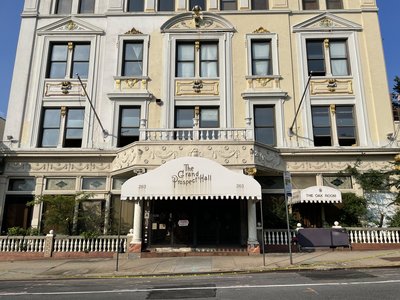We make your dreams come true!
That was the slogan from the iconic Grand Prospect Hall commercials that aired on televisions throughout the five boroughs for decades. Located on Prospect Avenue directly off of Fifth Avenue, the famous ballroom has been in place for 129 years and is a one-of-a-kind Victorian structure in the heart of Brooklyn.
For over a century, the ballroom has been the site of countless family gatherings, wedding receptions, and birthday parties. Since 1981, Greek couple Michael and Alice Halkia have owned the property and starred in charming advertisements that introduced the venue to a new generation of New Yorkers.
The pair even became national celebrities, earning appearances on “Saturday Night Live” and “Jimmy Kimmel Live.”
Now, the ballroom’s many satisfied guests have one more dream: saving the Grand Prospect Hall.
Following Michael’s death in 2020 from COVID-19, the Halkia family sold the property to Angelo Rigas for $22.5 million. Rigas is a newcomer to the New York real estate game, but his father Gregory Rigas has previously built multiple projects throughout the borough, including a tower at 574 4th Avenue not too far from Grand Prospect Hall.
The younger Rigas filed for a demolition permit on July 23. If the Department of Buildings approves the permit, the entire building could be torn down. Even without the permit, the new owner has already started gutting the hall’s interior.
In response, concerned Brooklynites have banded together to protect the century-old Victorian structure. Two surprisingly young Brooklynites, 16-year-old Solya Spiegel and 18-year-old Tommy Pannone, created a petition demanding that Grand Prospect Hall be granted landmark status. So far, the petition has received over 3,100 signatures.
“Grand Prospect Hall is an icon of Brooklyn, and has been standing as a communal space where Brooklynites come to celebrate ever since its construction in 1892,” the petition reads. “This is an obscene development, and if the Department of Buildings chooses to approve this demolition, over a century of Brooklyn history will be gone.”
Councilman and Democratic candidate for comptroller Brad Lander supports landmarking the building.
“The Grand Prospect Hall has long served as a civic institution, where Williams Jennings Bryan spoke in 1908 and the Women’s Suffrage Party launched its national campaign in 1914,” Lander wrote in a statement. “Prospect Hall served as a bridge between the old country and new, welcoming and easing the experience of strangers in a strange new homeland.”
Grand Prospect Hall’s protectors were granted a little more time early this month, when the city ordered a partial stop-work order on the interior demolition. The order was given to ensure the preservation of a Polish American WWII Veterans memorial in the hall’s eastern courtyard.
The memorial was put in place by a Polish-American organization that lost the hall in foreclosure during the 70s, allowing the Halkias family to purchase the property.
During a press conference this Monday, Mayor Bill de Blasio also advocated for saving at least the façade of the iconic structure.
“I remember going there for so many community events and it was a place people cherished. It was part of history, and you felt a connection to just all the history of Brooklyn, all the families who have been there before,” the Mayor said. “So, it’s really sad. But if there’s a way to save the façade and some of the history, we should certainly try to do that.”
Although it is not a landmark, the Grand Prospect Hall was added to the National Register of Historic Places in 1999. The register’s account of the hall praises its architectural splendor and technological innovations, including the oldest operational elevator in Brooklyn. It also speaks of the building’s importance to New York’s many immigrant communities.
“Prospect Hall has always made a monumentally large presence within its surrounding areas,” the account read. “In addition to its significance as an outstanding specimen of its architectural type and period, Prospect Hall is an important example of a large ethnic social, cultural, and entertainment facility, a building type that existed in large urban immigrant neighborhoods nationwide at the turn of the 20th century.
“Built at a peak period of European immigration, buildings of this type played an important role in facilitating the assimilation of the vast populations of America’s newcomers,” it continued.
The petition to save the Grand Prospect Hall is available on Change.org.



